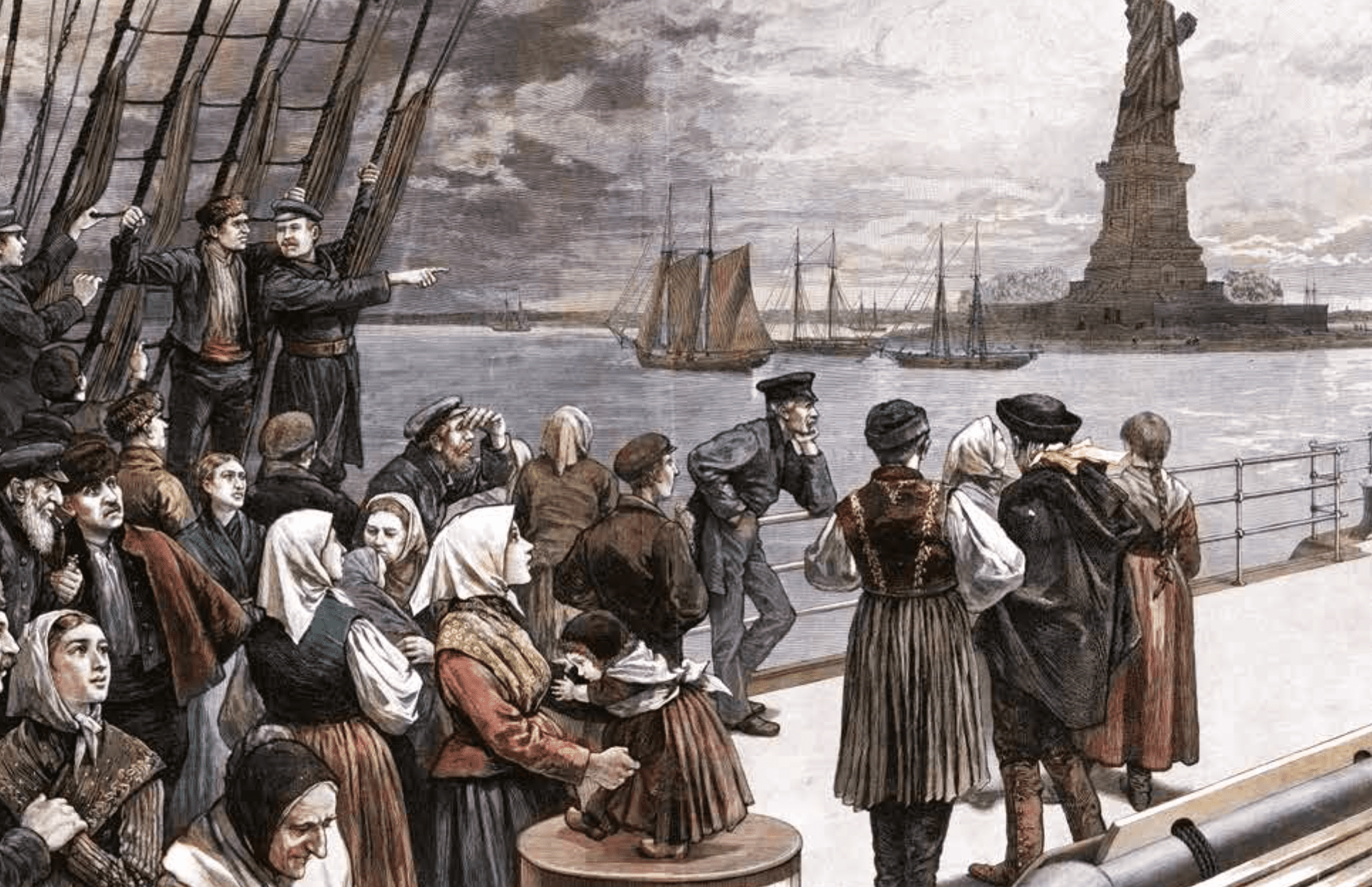Most of the public discussion around immigration is centred on border enforcement and the related issue of asylum. This is understandable given the ongoing dramas at the US–Mexico border, the Mediterranean, and the English Channel. But for countries of immigration—which include not only the US, Canada, and Australia, but also many European nations which have not traditionally thought of themselves as such—the larger question is what the policy regarding legal immigration should be. How many foreigners should be admitted for permanent residence? How should they be selected?
In considering these questions, our minds often turn to the differences between immigrants past and present. Today’s immigrants are less likely to be from Europe, less likely to be white, less likely to be Christian. There is no denying such differences. From ordinary Americans concerned about today’s mass immigration you will often hear objections along the lines of ‘My grandmother from Palermo didn’t use welfare—what’s wrong with immigrants today?’ Or ‘My great-grandfather from Odessa learned English and wanted to be an American—what’s wrong with immigrants today?’
Modernity, both for better and for worse, has wrought changes not only of degree but of kind
What such complaints—from decent, well-meaning people for the most part— miss is that what makes immigration today so much more problematic than it was a century or two ago is that we are different. Immigrants are the same sort of people they have always been—not usually the poorest of the poor, but a few notches up from the bottom, people with a little more get-up-and-go than those who stay behind. But they are travelling to destinations that are utterly different from a century ago. Modernity, both for better and for worse, has wrought changes not only of degree but of kind. The Western countries people want to move to today have post-industrial, knowledge-based economies, extensive welfare states, low fertility, and are part of a global system of communication and transportation that dramatically shrinks the world. All these developments—unprecedented in human history—make large-scale immigration riskier and more potentially harmful than ever before for the generally agreed-upon goals of modern societies: physical security, broadly shared prosperity, responsible systems of social provision for the poor, and sufficient social solidarity to make democracy sustainable.
Put simply, mass immigration is incompatible with the goals and characteristics of modern society. Think of it like pastry—as a child, it is good for you, because your growing body needs the fat and calories it provides in such abundance. But in middle age, you have to be more careful—the pastry is not really different, but you are, your metabolism has changed such that you need to cut back and be much more careful about your intake. Similarly, the metabolism of modern societies has changed, and so their immigration policies must change to maintain good health. Let us look first at the economic consequences of mass immigration into a modern society.
Economy: Cheap Labour vs Modern Economy
The key to the economic facet of the conflict between mass immigration and the modern society is the fact that immigration continually floods the labour market with less-skilled, lower-wage workers. This loosens the market for such workers, creating a buyer’s market for labour, where more workers chase fewer jobs. In a loose labour market created by immigration, employers do not have to compete as fiercely with one another to hire and retain workers by offering higher wages, better benefits, or more appealing working conditions. Instead, it is workers who have to compete with one another to find and keep jobs, by accepting lower wages and fewer benefits, and some will drop out of the job market altogether.
Although much of the economic analysis of immigration rightly looks at its effects on native-born workers with relatively little schooling, it is important to note that those at the margins of the economy include more than just the less-educated. Those harmed by artificially loose labour markets include all those whom employers might consider to be less desirable workers—the young and the old seeking part-time work, mothers of young children looking for flexible hours, the physically and mentally handicapped, ex-convicts attempting to rebuild their lives, recovering addicts, and even earlier immigrants struggling for advancement in communities constantly supplied with new competitors.
Of course, immigration has always added workers to the economy. But our economy has changed. Earlier waves of newcomers came to countries either settling the land or undergoing industrialization, which offered those with little education opportunity for upward mobility. Today we are in a post-industrial era, with less than 15 per cent of our workforce in either farming or goods production (manufacturing, construction, or mining).
Into this twenty-first-century economy, we have resumed the importation of what amounts to nineteenth-century foreign labour. The contrast with American workers is stark: among the working-age in the United States, only about 8 per cent of the native-born have less than a high-school education, compared to 24 per cent of the foreign-born. And the flow has been large enough to skew the labour market; while immigrants account for about 17 per cent of all workers, they make up fully 38 per cent of workers lacking a high school degree, resulting in an artificially bloated low-skilled labour force.
The consequences of the large-scale importation of less-skilled workers are clear. The National Academies of Sciences, Engineering, and Medicine (NAS) in the United States published a magisterial study1 spelling out the economic and fiscal consequences of today’s mass immigration flows. While the numbers from the 2016 study will have changed somewhat, the underlying facts have not.
The first takeaway from the report is that immigration does, in fact, create a net economic benefit for the nation, to the tune of $54 billion. But that net number hides several issues. First, it is tiny given the size of the economy and the scale of immigration: the report estimated a mere 0.31-per-cent increase in income for native-born Americans from this historically unprecedented wave of immigration.
Second, this net number obscures the winners and losers. While businesses gained $548 billion from the wage suppression caused by immigrant competition, that competition reduced the wages of native-born workers by some $494 billion, resulting in that net gain of $54 billion. In other words, mass immigration under today’s conditions is a reverse Robin Hood wealth-redistribution programme, taking from those competing with immigrants and giving to those using immigrant labour.
This is a value question—is it right to beggar the poor to provide a small increase in earnings to the rest of society (through lower costs for goods and services provided by immigrants)? If our goal is to avoid exacerbating wealth inequalities and to foster a sense of social solidarity across class and other lines, then continuing the mass arrival of people from abroad is clearly a mistake.
Finally, the NAS report found that immigrant earnings are catching up with natives more slowly that in the past; in the words of the report, there is a ‘slowing rate of wage convergence for immigrants admitted after 1979’. This slower rate of immigrant advancement remains even after controlling for education, suggesting that this is a feature of the changes undergone by a post-industrial economy.
Straining Public Finances
A second area where mass immigration conflicts with the goals and characteristics of a modern society is in the area of taxpayer-funded government services. Government spending has increased immensely over the past century, both in its total volume and the share of GDP. In the United States, for instance, spending by all levels of government went from around 3 per cent of GDP in 1900 to 46 per cent in 2020. And the share was even higher in almost all other developed nations.2
Most of this spending was on social services of various kinds, including health care, education, old-age pensions, provision for the poor, and the like. The government’s role in providing these services is an integral part of any modern society that even most conservatives have come to accept. As Robert Rector of the conservative Heritage Foundation in Washington, DC, put it, ‘Transfer or redistribution policies are a pervasive, if not predominant, government activity in all modern societies’.3 The immigration problem was summed up by Nobel-prize-winning economist Milton Friedman, addressing just one part of the fiscal-costs issue: ‘It’s just obvious that you can’t have free immigration and a welfare state.’
While sensational tabloid tales of immigrant welfare cheats are not made-up, they are not the source of the problem
The fiscal tension between mass immigration and the modern state is not the result of any moral defect on the part of newcomers. Few people in Tegucigalpa or Bamako dream of moving north to live off the dole. While sensational tabloid tales of immigrant welfare cheats are not made-up, they are not the source of the problem. Instead, immigrants who come with relatively little education find jobs that inevitably have low pay; in the US, immigrants are about 50 per cent more likely to live in poverty than the native-born. As a result, those immigrants pay little in taxes but are more likely to qualify for means-tested government services. What is more, newcomers generally have larger families, and much of government spending is directed toward children.
The result is widespread immigrant use of welfare. Nearly half of households in the United States headed by an immigrant (legal or illegal) use at least one major federal welfare programme. While the use of such means-tested benefits by native-headed households is also alarmingly high, at 32 per cent, immigrant use is half-again higher. And immigrant welfare use seems to increase over time, from 44 per cent for households headed by an immigrant who had lived in the US for 10 years or fewer, to 50 per cent for those who have been in the country for more than 10 years.4
Of course, immigrants—however modest their earnings—still pay taxes. So the NAS study referenced above ran eight different scenarios with differing assumptions about taxes paid and services used by immigrants and their dependent children. In every iteration, immigrants were a net drain on public finances, perhaps as much as $299 billion per year. And in every one of the scenarios, the fiscal drain was greater than the $54 billion net economic benefit discussed above.
In the words of two welfare scholars, ‘This very expensive assistance to the least advantaged American families has become accepted as our mutual responsibility for one another, but it is fiscally unsustainable to apply this system of lavish income redistribution to an inflow of millions of poorly educated immigrants’.5
Assimilation
A third theatre of conflict between mass immigration and modern society is in the area of assimilation. The most important measure of the success of an immigration policy is whether the newcomers and their children come to fully identify with their new country. US President Theodore Roosevelt expressed the bargain between the newcomer and the receiving society this way: ‘if the immigrant who comes here does in good faith become an American and assimilates himself to us, he shall be treated on an exact equality with everyone else, for it is an outrage to discriminate against any such man because of creed or birthplace or origin’6.
Accounting for national differences, this is the approach successful immigrant-receiving nations have long taken. It means being adopted by a new people, as a child is adopted into a family, sharing in the glories and heroes of the nation’s past, as well as in its failures and shame. Two aspects of modernity complicate such assimilation, one positive, the other negative.
The positive is the remarkable advance in transportation and communications technology. We traverse distances in hours that would have taken weeks, even months, in earlier generations. Cell phones and the internet allow for the instantaneous exchange of audio and video information in a way that was inconceivable even a few decades ago. This has been a boon in myriad ways.
But this shrinking of the world also creates problems for assimilation. Successful assimilation obliges the newcomer to uproot not only physically, but also in his or her psychological and emotional attachments, transferring them to this new home. But with cheap and easy communications and transportation, it is much easier than in the past for an immigrant to maintain ties with the old country. The impulse to do so is natural and even commendable, and has nothing to do with race or country of origin. But it is necessary for those ties to atrophy—and such atrophy is necessarily slower and less thorough now than in earlier times.
Princeton University sociologist Alejandro Portes summed up the situation: ‘Earlier in the twentieth century, the expense and difficulty of long-distance communication and travel simply made it impossible to lead a dual existence in two countries. Polish peasants couldn’t just hop a plane—or make a phone call, for that matter—to check out how things were going at home over the weekend.’7
But now they can. As a New York Times article put it some years back: ‘Armed with cut-rate phone cards and frequent-flier miles, with modems, fax machines and video cameras, immigrants can participate in the lives of their families back home—be they in Barbados or Tibet—with an immediacy unknown to any previous generation.’8
A century ago, the robust promotion of ‘Americanization’ was a hallmark of all institutions, public and private, with which immigrants interacted
These modern technologies foster the creation of transnational immigrant communities that cross boundaries and undermine the rootedness needed to foster emotional assimilation and national cohesion. Wellesley College sociologist Peggy Levitt calls communities like this ‘transnational villages’. She described one such community split between the original village in the Dominican Republic and the neighbourhood in Boston where many people from the village settled. In a way impossible in earlier eras, people watch the same soap operas, telephone contacts become ever more frequent as rates fall, gossip travels instantly between the two halves of the village, parents in one half try to raise children in the other, the same political parties operate in both places, and air travel allows people to go home for long weekends or split their time between the two communities. In short, she writes that modern technology ‘keeps people connected to one another in unprecedented ways and reinforces their ties to one another’.9 The second, negative, aspect of modernity that complicates assimilation is the ambivalence of the leadership classes about their own nations, leading them to recoil from the very idea of assimilating newcomers. A century ago, the robust promotion of ‘Americanization’ was a hallmark of all institutions, public and private, with which immigrants interacted. The elites who run those same institutions today—in government, business, education, religion, philanthropy, journalism, etc.—might be most accurately described as ‘post-American’. That is to say, they are not necessarily anti-American, but they lack the visceral emotional attachment to the American national community that is the mark of patriotism. Instead, they see themselves chiefly as ‘citizens of the world’, and are thus unwilling to cultivate in immigrants the patriotism that the elites themselves lack.
Note that this resistance to patriotic assimilation does not come from the immigrants. Today’s newcomers are no less or more interested in Americanization than their predecessors a century ago. Rather, it is America’s elites and institutions that are ambivalent—at best—about assimilation. And this ambivalence is not a superficial phenomenon that we can change simply with the passage of a new law; it is deeply rooted in every institution of our society.
We can even see a process of de-Americanization taking place in our schools, probably the single most important assimilating institutions. Sociologists Alejandro Portes and Ruben Rumbaut studied thousands of children of immigrants in San Diego and South Florida over a period of several years.10 Most interesting for our purposes was their analysis of how these young people identified themselves in terms of ethnic or national identity, something the students were asked when they were starting high school and again when they were finishing.
When first surveyed, the majority of the students identified themselves as American in some form, either as simply ‘American’ or as a hyphenated American (Cuban-American, for instance, or Filipino-American). After several years of American high school, barely one third still identified themselves as Americans, the majority choosing an identification with no American component at all, opting for either a foreign national-origin identity (Cuban, Filipino) or a pan-racial identity (Hispanic, Asian).
As the authors sum up: ‘The shift, therefore, has not been toward mainstream identities but toward a more militant reaffirmation of the immigrant identity for some groups (notably Mexicans and Filipinos in California and Haitians and Nicaraguans in Florida) and toward panethnic minority-group identities for others.’11
What Is to Be Done?
The solution is not zero immigration, but rather ‘zero-based budgeting’ in immigration. A modern, developed society does not need any immigration, but there are narrow categories of people whose admission is so compelling that we should admit them despite the challenges it can pose for modern societies.
All immigration flows are made up of three components—family, skills, and the humanitarian dimension. Family immigration should be limited to the spouses and dependent children of citizens. There is much fraud even now in spousal immigration, not to mention abuses, such as young citizen girls being forced to marry older men from abroad so they can gain residency.12 But as a citizen of your nation, you have the right to expect your fellow citizens to delegate to you the decision of whom to marry or adopt, even if they are from abroad. But only this nuclear family connection should give rise to special immigration privileges; US immigration policy is especially promiscuous in allowing family immigration, resulting in never-ending migration chains.
Skilled immigration should be limited to the world’s top talents, people with unique, remarkable abilities, and not ordinary white-collar workers with average skills. Corporate lobbyists’ panicked talk of a global competition for talent and their propagation of the myth of best-and-brightest immigrants have deformed the skilled immigration policies of advanced nations. Most foreigners who come via this route are not exceptional and, in fact, their large-scale admission causes native talent to pursue other careers. The result is a vicious circle: foreigners are imported to address a shortage of, say, nurses, thus short-circuiting the natural market mechanisms that would have addressed such a shortage, and then self-interested commenters say they cannot do without imported nurses!
Finally, humanitarian immigration— asylum and refugee flows—should be restricted to people who literally cannot stay where they are for another second and have absolutely nowhere else to go. The United Nations High Commissioner for Refugees keeps a list of such emergency resettlement cases, and the list is not long. As for asylum—i.e., illegal immigrants who claim refugee status—our current arrangements date from the immediate aftermath of the Second World War and are unsustainable anachronisms in the modern world. Changes both to the definition of a refugee and to the means of processing—requiring off-shore application, for instance—are required for modern nations to re-assert control over their borders.
There will always be migration. But new circumstances require new policies. In the words of President Abraham Lincoln, ‘As our case is new, so we must think anew, and act anew. We must disenthrall ourselves, and then we shall save our country.’13
NOTES
1 Center for Immigration Studies, ‘National Academy of Sciences Study of Immigration: Workers and Taxpayers Lose, Businesses Benefit’, CIS.org (21 September 2016), https://cis.org/Press-Release/ National-Academy-Sciences-Study-Immigration- Workers-and-Taxpayers-Lose-Businesses.
2 IMF, ‘World Economic Outlook Databases’, IMF.org (October 2021), www.imf.org/en/ Publications/SPROLLs/world-economic-outlook- databases#sort=%40imfdate%20descending.
3 Robert Rector, ‘Setting the Record—and the Research—Straight: Heritage Responds (again) to the Wall Street Journal ’, The Heritage Foundation (12 June 2007), www.heritage.org/immigration/commentary/ setting-the-record-and-the-research-straight-heritage- responds-again-the.
4 Steven A. Camarota, ‘Welfare Use for Immigrants and Native-Born Households’, CIS.org (1 September 2021), https://cis.org/Camarota/Welfare-Use- Immigrants-and-NativeBorn-Households.
5 Christine Kim and Robert Rector, ‘Executive Summary: The Fiscal Cost of Low-Skill Immigrants to the U.S. Taxpayer’, The Heritage Foundation (21 May 2007), www.heritage.org/immigration/ report/executive-summary-the-fiscal-cost-low-skill- immigrants-the-us-taxpayer.
6 Theodore Roosevelt quoted at TR Inaugural Site, www.trsite.org/explore/social-issues-of-trs-day, accessed 19 January 2022.
7 Alejandro Portes, ‘Global Villagers: The Rise of Transnational Communities’, The American Prospect, 25 (March-April 1996): 74–77, http://maxweber.hunter.cuny.edu/pub/eres/BLPR102_PIMENTEL/Portes.html.
8 Deborah Sontag and Celia W. Dugger, ‘The New Immigrant Tide: A Shuttle between Worlds’, The New York Times (19 July 1998), www.nytimes. com/1998/07/19/nyregion/the-new-immigrant-tide-a- shuttle-between-worlds.html.
9 Peggy Levitt, The Transnational Villagers (2001), www.ucpress.edu/book/9780520228139/the- transnational-villagers.
10 Rubén G. Rumbaut, ‘Coming of Age in Immigrant America’, Research Perspectives on Migration, 1/6 (January–February 1998), https://carnegieendowment.org/files/rpm/rpmvol1no6.pdf.
11 Rumbaut, ‘Coming of Age in Immigrant America’.
12 Sasha K. Taylor, ‘For the sake of a visa, I was forced into marriage in Arizona—at age 15’, The Washington Post (19 January 2022), https://www.washingtonpost. com/opinions/2022/01/19/forced-marriage-children- immigration-visa/.
13 Abraham Lincoln, ‘Annual Message
to Congress – Concluding Remarks, Washington D.C., 1 December 1862’, Abraham Lincoln Online, www.abrahamlincolnonline.org/lincoln/speeches/ congress.htm, accessed 19 January 2022.








